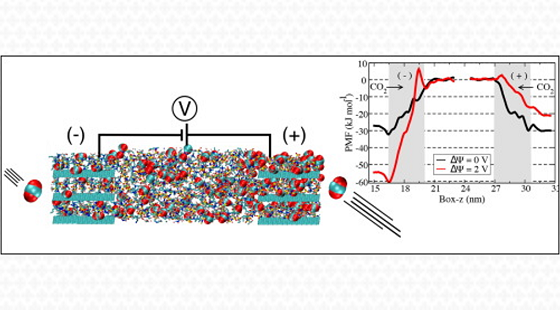Researchers investigate CO2 capture in a new material

A computational study carried out by CINE researchers allowed us to understand how carbon dioxide (CO2) molecules are absorbed in an innovative material based on an ionic liquid (a family of salts that are liquid at room temperature).
The research contributes to the development of strategies for capturing this greenhouse gas and, therefore, it is part of the worldwide efforts to have a set of technologies that help reduce carbon emissions.
One of the strategies being studied is the use of materials that absorb CO2, so that the gas is retained there or it is removed from the material for use or disposal. In this context, this new work investigated the possibilities offered by a system formed by two porous carbon plates and an ionic liquid confined in the middle of the plates and inside the pores.
Using Molecular Dynamics simulations (a computational method for analyzing the movements of atoms and molecules), the authors investigated the influence of voltage and of different pore sizes (between 0.75 nm and 1.5 nm) on CO2 absorption. Among other results, the scientists discovered that the voltage increases the amount of carbon dioxide inside the pores and also augments the rate of absorption of these molecules in the ionic liquid confined between the plates. Furthermore, they confirmed that gas absorption is faster in larger pores.
The results open possibilities for new studies with potential applications. “In theory, we can imagine devices like this coupled to systems where there is combustion, such as industries and vehicles, or applied to the separation/purification of gases of interest”, says Rafael Guimarães Pereira, who conducted the research work as part of his doctorate at UNIFESP under the supervision of Professor Leonardo J. A. Siqueira. “In the latter case, studies must be carried addressing the selectivity regarding the gaseous mixture”, he explains.
The research received funding from the São Paulo State Research Foundation, Shell and Capes (Brazilian federal agency) and strategic support from ANP. The authors used computational resources from CENAPAD-SP and LNCC.
Paper reference: Understanding CO2 absorption by an ammonium-based ionic liquid confined in porous carbon material under applied voltage. Rafael Guimarães Pereira, Victor Oliveira Valente, Rafael Maglia de Souza, Leonardo José Amaral Siqueira. Journal of Molecular Liquids, Volume 366,120227. https://doi.org/10.1016/j.molliq.2022.120227.
Paper authors who are CINE members: Rafael Guimarães Pereira (PhD student at UNIFESP/Diadema), Victor Oliveira Valente (Scientific Initiation student at UNIFESP/Diadema), Rafael Maglia de Souza (Researcher at IQ/USP) and Leonardo José Amaral Siqueira (Professor at UNIFESP/Diadema).
Contact

Leonardo José Amaral Siqueira
UNIFESP











